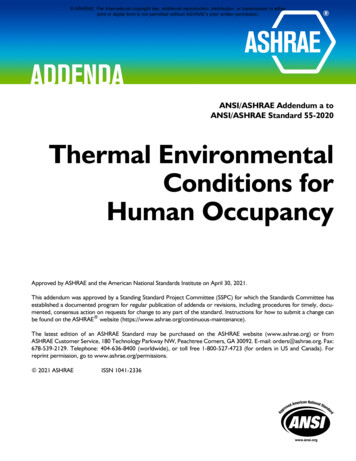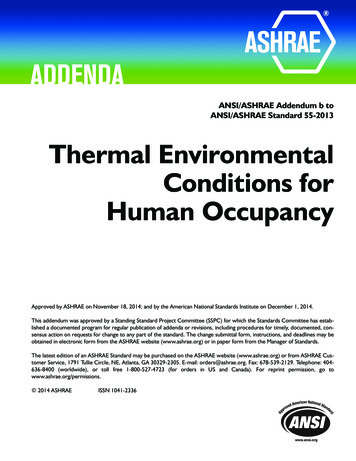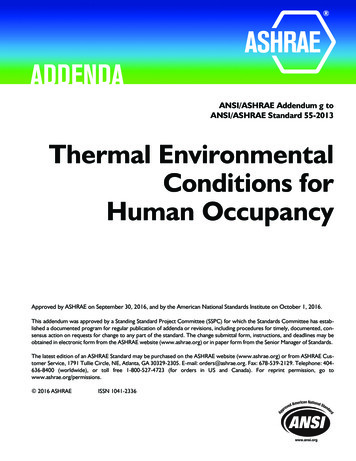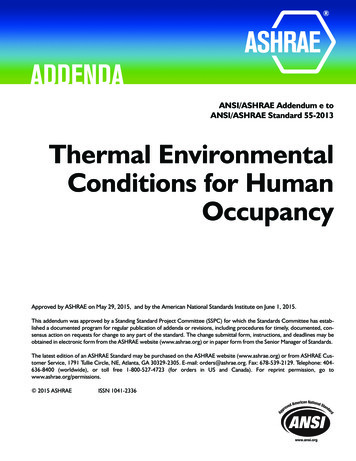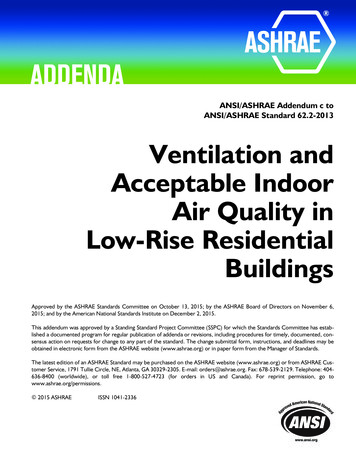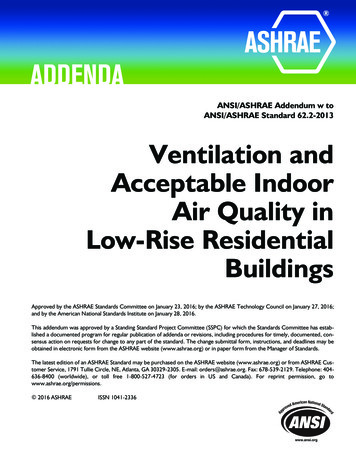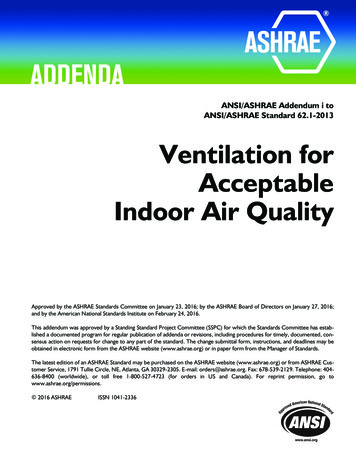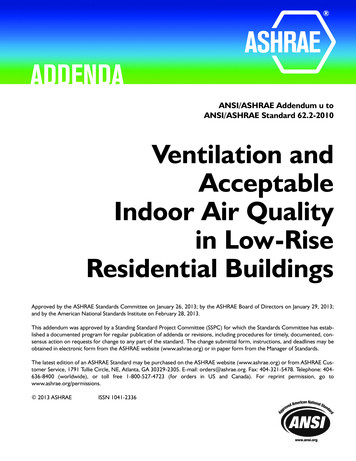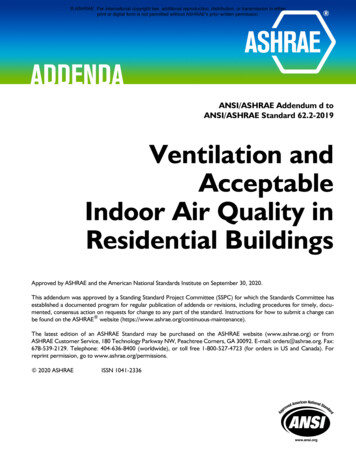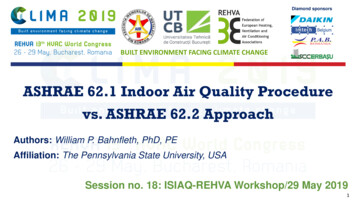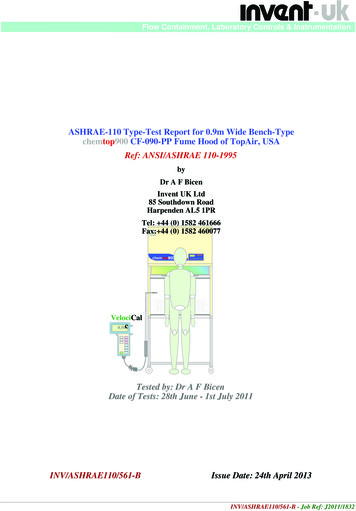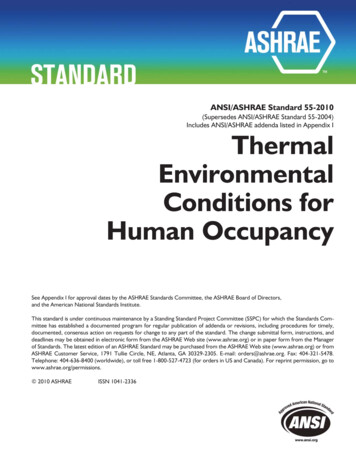
Transcription
ASHRAE. Per international copyright law, additional reproduction, distribution, or transmission in eitherprint or digital form is not permitted without ASHRAE's prior written permission.ANSI/ASHRAE Addendum d toANSI/ASHRAE Standard 55-2017Thermal EnvironmentalConditions forHuman OccupancyApproved by ASHRAE and the American National Standards Institute on July 31, 2020.This addendum was approved by a Standing Standard Project Committee (SSPC) for which the Standards Committee hasestablished a documented program for regular publication of addenda or revisions, including procedures for timely, documented, consensus action on requests for change to any part of the standard. Instructions for how to submit a change canbe found on the ASHRAE website e latest edition of an ASHRAE Standard may be purchased on the ASHRAE website (www.ashrae.org) or fromASHRAE Customer Service, 1791 Tullie Circle, NE, Atlanta, GA 30329-2305. E-mail: orders@ashrae.org. Fax: 678-5392129. Telephone: 404-636-8400 (worldwide), or toll free 1-800-527-4723 (for orders in US and Canada). For reprint permission, go to www.ashrae.org/permissions. 2020 ASHRAEISSN 1041-2336
ASHRAE. Per international copyright law, additional reproduction, distribution, or transmission in eitherprint or digital form is not permitted without ASHRAE's prior written permission.ASHRAE Standing Standard Project Committee 55Cognizant TC: 2.1, Physiology and Human EnvironmentSPLS Liaison: Karl L. PetermanAbhijeet Pande*, ChairDavid Heinzerling*, Vice-Chair/WebmasterJosh Eddy*, SecretaryPeter F. Alspach*Edward A. Arens*Robert Bean*Richard de DearThomas B. Hartman*Daniel Int-Hout, IIIKristof IrwinEssam E. Khalil*Dolaana Khovalyg*Mikhail Koupriyanov*Baizhan LiRodrigo Mora*Francis J. Offermann*Gwelen PaliagaZaccary A. Poots*Lawrence J. Schoen*Peter SimmondsAaron R. SmithPriyam TewariJohn G. Williams** Denotes members of voting status when the document was approved for publicationASHRAE STANDARDS COMMITTEE 2020–2021Drury B. Crawley, ChairRick M. Heiden, Vice ChairEls BaertCharles S. BarnabyRobert B. BurkheadThomas E. CappellinDouglas D. FickWalter T. GrondzikSusanna S. HansonJonathan HumbleSrinivas KatipamulaGerald J. KettlerEssam E. KhalilMalcolm D. KnightJay A. KohlerLarry KoumaCesar L. LimJames D. LutzKarl L. PetermanErick A. PhelpsDavid RobinLawrence J. SchoenSteven C. SillRichard T. SwierczynaChristian R. TaberRussell C. TharpTheresa A. WestonCraig P. WrayJaap Hogeling, BOD ExOWilliam F. McQuade, COConnor Barbaree, Senior Manager of StandardsSPECIAL NOTEThis American National Standard (ANS) is a national voluntary consensus Standard developed under the auspices of ASHRAE. Consensus is definedby the American National Standards Institute (ANSI), of which ASHRAE is a member and which has approved this Standard as an ANS, as“substantial agreement reached by directly and materially affected interest categories. This signifies the concurrence of more than a simple majority,but not necessarily unanimity. Consensus requires that all views and objections be considered, and that an effort be made toward their resolution.”Compliance with this Standard is voluntary until and unless a legal jurisdiction makes compliance mandatory through legislation.ASHRAE obtains consensus through participation of its national and international members, associated societies, and public review.ASHRAE Standards are prepared by a Project Committee appointed specifically for the purpose of writing the Standard. The ProjectCommittee Chair and Vice-Chair must be members of ASHRAE; while other committee members may or may not be ASHRAE members, allmust be technically qualified in the subject area of the Standard. Every effort is made to balance the concerned interests on all Project Committees.The Senior Manager of Standards of ASHRAE should be contacted fora. interpretation of the contents of this Standard,b. participation in the next review of the Standard,c. offering constructive criticism for improving the Standard, ord. permission to reprint portions of the Standard.DISCLAIMERASHRAE uses its best efforts to promulgate Standards and Guidelines for the benefit of the public in light of available information and acceptedindustry practices. However, ASHRAE does not guarantee, certify, or assure the safety or performance of any products, components, or systemstested, installed, or operated in accordance with ASHRAE’s Standards or Guidelines or that any tests conducted under its Standards or Guidelineswill be nonhazardous or free from risk.ASHRAE INDUSTRIAL ADVERTISING POLICY ON STANDARDSASHRAE Standards and Guidelines are established to assist industry and the public by offering a uniform method of testing for rating purposes, bysuggesting safe practices in designing and installing equipment, by providing proper definitions of this equipment, and by providing other informationthat may serve to guide the industry. The creation of ASHRAE Standards and Guidelines is determined by the need for them, and conformanceto them is completely voluntary.In referring to this Standard or Guideline and in marking of equipment and in advertising, no claim shall be made, either stated or implied,that the product has been approved by ASHRAE.ASHRAE is a registered trademark of the American Society of Heating, Refrigerating and Air-Conditioning Engineers, Inc.ANSI is a registered trademark of the American National Standards Institute.
ASHRAE. Per international copyright law, additional reproduction, distribution, or transmission in eitherprint or digital form is not permitted without ASHRAE's prior written permission.(This foreword is not part of this standard. It is merely informative and does not containrequirements necessary for conformance to the standard. It has not been processedaccording to the ANSI requirements for a standard and may contain material that hasnot been subject to public review or a consensus process. Unresolved objectors on informative material are not offered the right to appeal at ASHRAE or ANSI.)FOREWORDAddendum d removes the Graphical Comfort Zone Method (Section 5.3.1) from the standardand replaces it with example graphics using the Analytical Comfort Zone Method (Section5.3.2) and the Elevated Air Speed Comfort Zone Method (Section 5.3.3). All references to thegraphical method have been removed, and section headings have been updated.Note: In this addendum, changes to the current standard are indicated in the text by underlining (for additions) and strikethrough (for deletions) unless the instructions specifically mention some other means of indicating the changes.Addendum d to Standard 55-2017Modify Section 5.3 as shown.5.3 Method for Determining Acceptable Thermal Environment in Occupied Spaces. Section 5.3 is permitted to be used to determine the requirements for thermal comfort in all occupied spaces within the scope of this standard.Acceptable thermal environments shall be determined using one of the three two methodsshown in Table 5.3.1 and any applicable requirements of Sections 5.3.45.3.3 and 5.3.55.3.4.Informative Note: Average air speed and average air temperature have precise definitionsin this standard. See Section 3 for all defined terms.5.3.1 Graphic Comfort Zone Method5.3.1.1 Applicability. Use of this method shall be limited to representative occupants withmetabolic rates between 1.0 and 1.3 met and clothing insulation Icl between 0.5 and 1.0 clowho are not exposed to direct-beam solar radiation. Average air speed Va greater than 0.2 m/s(40 fpm) requires the use of Section 5.3.3.The Graphic Comfort Zone is limited to a humidity ratio at or below 0.012 kg·H2O/kg dryair (0.012 lb·H2O/lb dry air), which corresponds to a water vapor pressure of 1.910 kPa (0.277psi) at standard pressure or a dew-point temperature tdp of 16.8 C (62.2 F).5.3.1.2 Methodology. Figure 5.3.1 specifies the comfort zone for environments that meetthe above criteria. Two zones are shown—one for 0.5 clo of clothing insulation Icl and one for1.0 clo of insulation.Comfort zones for intermediate values of clothing insulation Icl shall be determined by linear interpolation between the limits for 0.5 and 1.0 clo using the following relationships:tmin, Icl [(Icl – 0.5 clo) tmin, 1.0 clo (1.0 clo – Icl) tmin, 0.5clo]/0.5 clotmax, Icl [(Icl – 0.5 clo) tmax, 1.0 clo (1.0 clo – Icl) tmax, 0.5clo]/0.5 clowheretmin, Icl lower operative temperature to limit for clothing insulation Icltmax, Icl upper operative temperature to limit for clothing insulation IclIcl thermal insulation of the clothing in question, cloAverage air speeds Va greater than 0.2 m/s (40 fpm) increase the lower and upper operativetemperature to limit for the comfort zone in accordance with Section 5.3.3.5.3.25.3.1 Analytical Comfort Zone Method5.3.2.15.3.1.1 Applicability. It is permissible to apply the method in this section to allspaces within the scope of this standard where the occupants have activity levels that result inaverage metabolic rates between 1.0 and 2.0 met. Average air speeds Va greater than 0.20 m/s(40 fpm) require the use of Section 5.3.35.3.2.5.3.2.25.3.1.2 Methodology. The computer code3 in Normative Appendix B is to be usedwith this standard. Compliance is achieved if –0.5 PMV 0.5. Alternative methods are permitted. If any other method is used, it is the user’s responsibility to verify and document thatANSI/ASHRAE Addendum d to ANSI/ASHRAE Standard 55-20171
ASHRAE. Per international copyright law, additional reproduction, distribution, or transmission in eitherprint or digital form is not permitted without ASHRAE's prior written permission.(a)(b)Figure 5.3.1 Graphic Comfort Zone Method: Acceptable range of operative temperature to and humidity for spaces that meetthe criteria specified in Section 5.3.1 (1.0 met 1.3; 0.5 clo 1.0)—(a) I-P and (b) SI.2ANSI/ASHRAE Addendum d to ANSI/ASHRAE Standard 55-2017
ASHRAE. Per international copyright law, additional reproduction, distribution, or transmission in eitherprint or digital form is not permitted without ASHRAE's prior written permission.Table 5.3.1 Applicability of Methods for Determining Acceptable Thermal Environments in OccupiedSpacesAverage Air Speed,m/s (fpm)Humidity RatiometcloComfort Zone Method 0.20 (40) 0.012 kg·H2O/kg dry air1.0 to 1.30.5 to 1.0Section 5.3.1, “Graphic Comfort Zone Method” 0.20 (40)All1.0 to 2.00 to 1.5Section 5.3.25.3.1, “Analytical Comfort ZoneMethod” 0.20 (40)All1.0 to 2.00 to 1.5Section 5.3.35.3.2, “Elevated Air Speed ComfortZone Method”the method used yields the same results. The ASHRAE Thermal Comfort Tool3 is permitted tobe used to comply with this section.Figure 5.3.1.1 provides graphical examples of comfort zones using the Analytical ComfortZone Method. Direct use of these charts to comply with the Analytical Comfort Zone Methodis allowable for the specific input conditions described on each chart. In each figure, the darkershade comfort zone is the same, and the lighter shade comfort zone represents a single alteredinput (a) clothing insulation and (b) metabolic rate.Informative Note: See Informative Appendix L for more explanation of predicted meanvote (PMV) and its relationship to predicted percentage dissatisfied (PPD).5.3.2.2.15.3.1.2.1 When direct-beam solar radiation falls on a representative occupant,the mean radiant temperature tr shall account for long-wave mean radiant temperature trlw andshort-wave mean radiant temperature trsw using one of the following options.a. Full calculation of mean radiant temperature tr as follows:1. Step 1: Determine long-wave mean radiant temperature trlw.2. Step 2: Determine short-wave mean radiant temperature trsw using Normative Appendix C.3. Step 3: Mean radiant temperature tr is equal to trlw trsw determined in Step 1 andStep 2b. Use a mean radiant temperature tr that is 2.8 C (5 F) higher than average air temperature taif all of the following conditions are met:1. A space with air temperature stratification less than Section 5.3.4.35.3.3.3.2. A space without active radiant surfaces.3. Building envelope opaque surfaces of the space (walls, floor, roof) meet U-value prescriptive requirement of ASHRAE/IES 90.12.4. Outside air temperature is less than 43 C (110 F).5. Vertical fenestration has less than 9 ft. (3 m) total height.6. No skylights are present.7. The space complies with all requirements in a single row of Tables 5.3.2.2.15.3.1.2.1A,B, C or D. Interpolation between values within a single table (5.3.2.2.15.3.1.2.1A, B, Cor D), but not between tables, is permissible. Solar absorptance properties for shade fabrics used in Tables 5.3.2.2.15.3.1.2.1A, B, C or D shall use the most similar color fromTable 5.3.2.2.15.3.1.2.1E unless more specific data are available from the manufacturer.Tables 5.3.2.2.15.3.1.2.1A through D show criteria that allow use of mean radiant temperature tr that is 2.8 C (5 F) higher than average air temperature ta for high-performance glazingunits (Table 5.3.2.2.15.3.1.2.1A); clear, low-performance glazing units (Table5.3.2.2.15.3.1.2.1B); tinted glazing units (Table 5.3.2.2.15.3.1.2.1C); and electrochromic glazing units (Table 5.3.2.2.15.3.1.2.1D). See Normative Appendix C Section C2(e) for a description of fbes.5.3.35.3.2 Elevated Air Speed Comfort Zone Method5.3.3.15.3.2.1 Applicability. It is permissible to apply the method in this section to allspaces within the scope of this standard where the occupants have activity levels that result inaverage metabolic rates between 1.0 and 2.0 met, clothing insulation Icl between 0.0 and 1.5clo, and average air speeds Va greater than 0.20 m/s (40 fpm).ANSI/ASHRAE Addendum d to ANSI/ASHRAE Standard 55-20173
ASHRAE. Per international copyright law, additional reproduction, distribution, or transmission in eitherprint or digital form is not permitted without ASHRAE's prior written permission.RELATIVE HUMIDITY (%)8010060This graph is only applicable for the
ANSI/ASHRAE Addendum d to ANSI/ASHRAE Standard 55-2017 3 the method used yields the same results. The ASHRAE Thermal Comfort Tool3 is permitted to be used to comply with this section. Figure 5.3.1.1 provides graphical examples of comfort zones using the Analytical Comfort Zone Method. Direct use of these charts to comply with the Analytical Comfort Zone Method is allowable for the specific .
